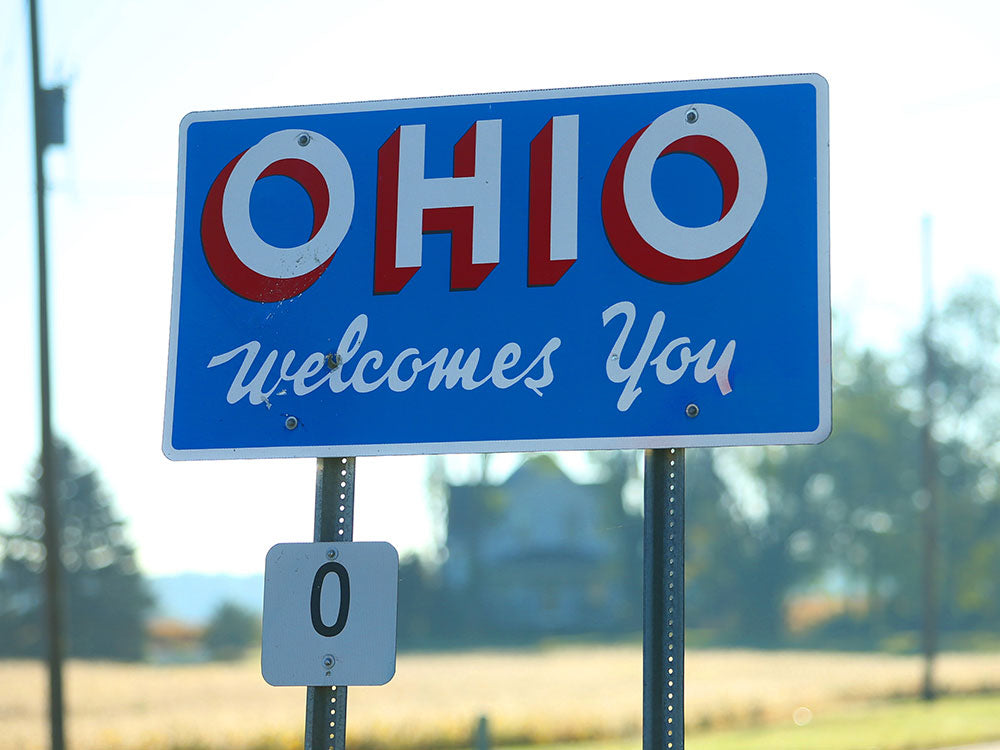Table of Content
1. Introduction
Riding a motorcycle can make for a fun experience, but not everything is going to be thrills and chills. There is work involved to ensure the safety of yourself, the well-being of other drivers, and that you follow the rules of the road. Depending on which region of the United States you are in, the regulations for motorcycle operation will differ. If you are heading to Ohio, it is your responsibility to become familiar with this information.
2. Ohio Motorcycle Insurance

Before you can be allowed to ride your motorcycle freely through Ohio, you are required to own Ohio motorcycle insurance. In the event you are involved in a motorcycle accident, the costs you would need to pay could strain your finances. Having liability insurance coverage helps cover the bulk of the compensation while confirming that you are financially responsible. You will have to carry physical documentation and must be able to show it at traffic stops, accident scenes, and vehicle inspections.
Whatever insurance company offering liability coverage for your motorcycle you go to, make sure that the plan deals with bodily injuries and property damages at a minimum:
$25,000 for bodily injury to a person per accident
$50,000 for bodily injuries to multiple people per accident
$25,000 for property damages sustained per accident
If you are not sure if coverage for injuries and destruction of personal belongings is adequate, you may want to incorporate other optional coverage in your Ohio motorcycle insurance plan:
Uninsured coverage
Underinsured coverage
Collision coverage
Comprehensive coverage
Medical payment coverage
Bodily injury coverage
3. Ohio Motorcycle Helmet Laws
In Ohio, you must put on a motorcycle helmet if you are under 18, currently hold a temporary motorcycle permit or have less than a year of riding experience.
Based on recent statistics provided by the Ohio State Patrol, motorcyclists have a need for motorcycle helmets now more than ever:
In 2020, there were a total of 3,982 motorcycle accidents that occurred in Ohio
Compared to 2019, 2020 saw an 11% in motorcycle-involved crashes
In 2020, About 60% of motorcyclists were considered at fault for motorcycle-involved crashes
In 2020, only 38% of motorcyclists involved in motorcycle accidents were wearing appropriate motorcycle helmets
Your motorcycle helmet should have been made by the Snell Memorial Foundation and has been approved by the U.S. Department of Transportation.
The types of models that meet the criteria provided above plus give you adequate protection and visibility are three-quarter and full-face helmets. If you are looking for a motorcycle helmet, make sure that they have the following features:
| Requirements | Three-Quarter Helmet | Full-Face Helmet |
|---|---|---|
| Has the Department of Transportation (DOT) sticker | ✔️ | ✔️ |
| Contours around your head to fit snugly due to comfort padding | ✔️ | ✔️ |
| No signs of damage Ex:// cracks, loose padding, scratches, or frayed straps | ✔️ | ✔️ |
| Has a face shield with no scratches | ❌ | ✔️ |
| Includes separate eye protection with no scratches Ex:// goggles, glasses | ✔️ | ❌ |
| Has a hard and durable outer shell that is shatter-resistant | ✔️ | ✔️ |
| Has an impact-absorbing liner inside the helmet | ✔️ | ✔️ |
| Gives you a clear, peripheral view of your surroundings | ✔️ | ✔️ |
| Securely fastened with neck- or chin-strap | ✔️ | ✔️ |
| Allows airflow without fogging up | ✔️ | ✔️ |
| Can allow you to wear sunglasses underneath | ✔️ | ✔️ |
4. Ohio Motorcycle License Laws
4.1 Ohio Temporary Motorcycle Instruction Permit
Upon reaching the age of 15 ½, you can try for an Ohio temporary motorcycle permit after you pay $22.50 for it to be issued.
To be given the permit, you must provide the appropriate forms and pass these qualifications:
Present full name and birth date
Provide proof of Ohio residency
Provide proof of U.S. citizenship
Provide your Social Security Number
Pass the knowledge exam
Pass the vision exam
Pay the required fees
Even after you get the permit, you still have to work up to get full use of your motorcycle. While you are practicing, there are certain tasks that you cannot do due to the mistakes a learning novice could make:
You cannot carry passengers
You can only operate during daylight hours
You cannot ride on interstates or congested roads
You must wear a motorcycle helmet
4.2 Ohio Motorcycle Endorsement
If you are 15 ½ or above, you can begin preparing to acquire an Ohio motorcycle endorsement. You will have to pay $24.50 for a 4-year endorsement or $48 for an 8-year endorsement to be added to your Ohio driver’s license.
Listed below are the requirements you will need to fulfill to obtain an Ohio motorcycle endorsement:
| Requirements | Applicants Ages 15 ½ to 17 | Applicants Ages 18 and Above |
|---|---|---|
| Have a valid Ohio driver’s license | ✔️ | ✔️ |
| Complete a Motorcycle Ohio Basic Course | ✔️ | ❌* |
| Complete 50 hours of driving including at least 10 hours of night driving | ✔️ | ❌ |
| Held onto an Ohio temporary motorcycle instruction permit for at least six months | ✔️ | ✔️ |
| Provide proof of Ohio motorcycle insurance | ✔️ | ✔️ |
| Provide proof of Ohio vehicle registration | ✔️ | ✔️ |
| Fill out the appropriate driver’s license application | ✔️ | ✔️ |
| Must have the consent of a parent or legal guardian if you are a minor | ✔️ | ❌ |
| Provide your social security number | ✔️ | ✔️ |
| Pay required fees | ✔️ | ✔️ |
| Present valid photo I.D. | ✔️ | ✔️ |
| Take a photo | ✔️ | ✔️ |
| Take vision exam | ✔️ | ✔️ |
| Pass the knowledge test | ✔️ | ✔️ |
| Pass the skills test | ✔️* | ✔️* |
| Provide proof of U.S. citizenship | ✔️ | ✔️ |
| Provide proof of residency in Ohio | ✔️ | ✔️ |
*While taking the Motorcycle Ohio Basic Course is only mandatory for minors, any legal adults may take it as well if they wish. Upon completion, they can waive the skills test within the next 60 days.
4.3 Ohio Motorcycle License Test

Written Portion:
Complete 40 multiple-choice questions
Questions will be based on content from Ohio Motorcycle Operator Manual
Requires a passing grade of 75% or higher
Riding Portion:
Will either be conducted in a controlled, off-street area
Your motorcycle will be subjected to a pre-ride inspection to ensure it meets safety standards
Demonstrate a basic understanding of motorcycle operation
You will be tested on your ability to stay within the speed limit, adjusting speed and position, maintaining visibility, operating under stress, accelerating, braking, turning, stopping, and swerving
The examiner will grade you based on how well you ride at safe speeds, stay within the lanes, and demonstrate riding maneuvers
5. Ohio Motorcycle Passenger Laws

Ohio does not have a minimum age that passengers need to meet or be above to be permitted onto a motorcycle.
You are only allowed to transport as many passengers as your vehicle is designed to carry without being detrimental to your vehicle’s performance. Your motorcycle must be outfitted with equipment to provide secure and safe seating for additional people. These will include a designated passenger seat, footrests, and handholds.
Your motorcycle passenger is not allowed to be seated in front of you and s/he must have a leg hanging on each side of the vehicle. The designated passenger seat can only be positioned at the following places on your motorcycle:
At the back of a large driver’s seat
Towards the rear as a separate saddle
Fixed to the side as a sidecar
As there is no age restriction, you must be discerning when determining who can safely ride along with you on your motorcycle. In general, it is best to not take on young children or elderly individuals as they may have difficulty planting their feet against the footrests. The following criteria are good indicators that a person can stay secure while the vehicle is in motion:
Your passenger must be able to reach the footrests
Your passenger must wear an approved motorcycle helmet
Your passenger cannot be carrying any packages
Your passenger must be able to understand and follow your directions
Your motorcycle should only be able to transport one other person
6. Ohio Lane Splitting Laws

In Ohio, motorcyclists are prohibited from doing lane splitting. Because traveling on top of the lanes and in between larger vehicles is considered too risky, riders should not attempt this for safety’s sake. You will be penalized for reckless driving if you attempt the following:
Riding on top of the dividing lines between lanes
Riding in between adjacent rows of stopped vehicles
Overtaking a larger vehicle ahead in the same lane
Motorcycles can pull off maneuvers that four-wheel vehicles cannot due to their compact size and slim chassis. Therefore, motorcyclists are still afforded liberties regarding how they can operate on Ohio’s roads:
You are allowed to make full use of the space within your current lane
-
You can only share a lane with another motorcycle if:
Both parties stay apart at least two abreast
Both parties consent beforehand
7. Ohio Motorcycle Safety Features

While conducting a periodic inspection on your ride may be the dullest part of owning a motorcycle, it is arguably the most important task you have to undertake. Checking the primary components are functioning correctlly will make sure that your motorcycle does not break down. The overall functionality of your motorcycle becomes compromised if even a single component becomes defective.
Horn
Wheels
Tires
Handlebars
Front and Rear Brakes
Controls
Headlight(s)
Taillight
Brake Light
Exhaust System
Muffler
Rearview Mirrors
8. Sources
- Ohio Motorcycle Operator Manual
- Ohio Bureau of Motor Vehicles - Mandatory Insurance
- Traffic Safety Bulletin May 2021 - Motorcycles in Ohio
- Ohio Bureau of Motor Vehicles - Operator Laws and Regulations
- Ohio Bureau of Motor Vehicles - Documents & Fees
- Ohio Bureau of Motor Vehicles - Motorcycle/Scooter License













Leave a comment
All comments are moderated before being published.
This site is protected by hCaptcha and the hCaptcha Privacy Policy and Terms of Service apply.